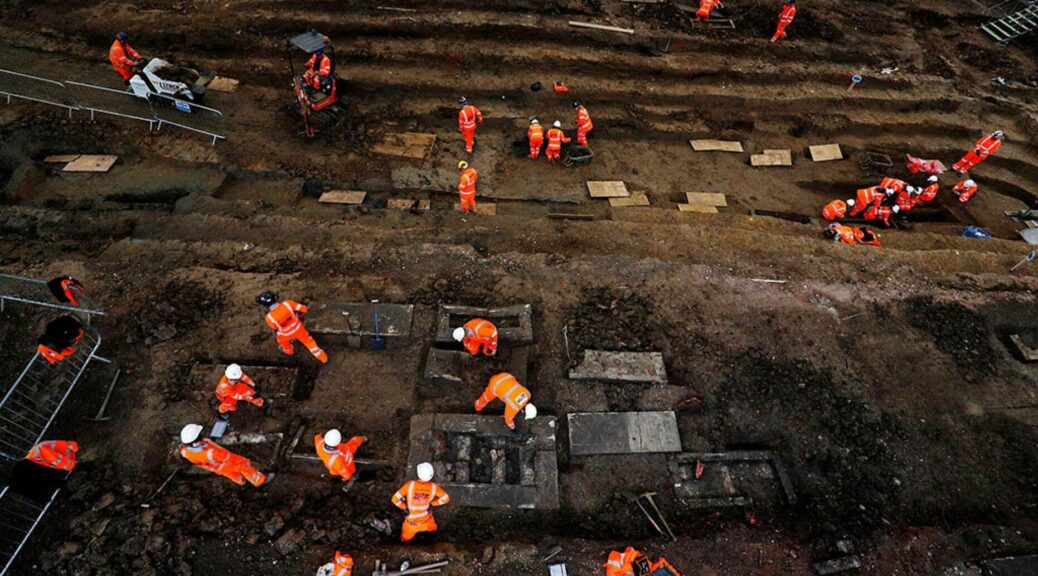Mass dig of 60,000 skeletons from 230-year-old cemetery set to expose London’s secrets
A mammoth dig is ongoing that is expected to Unearth 60,000 skeletons from a London cemetery that is 230 years old.
To date, 1,200 people’s bones have been exhumed from the burial ground near Euston Station to make way for the new high-speed railway between Birmingham and the capital.
The major dig show archeologists recently released photos clearing thick clay from coffins and brushing the dirt from remains. They are part of an archeological team on the 150-mile HS2 route that is currently delving into 10,000 years of British history.

Land at St James’s Gardens – the former site of a late 18th and 19th-century burial ground – is needed for Euston’s expansion. With tens of thousands of skeletons to be removed, protests and a memorial service have been held at the site where people were laid to rest from 1790 to 1853.
HS2 project bosses say that an estimated 60,000 people are buried there, including notable people such as Lord George Gordon, who in 1780 called for the repeal of the Catholic Relief Act and a return to the repression of Catholics.

He led a 60,000-strong crowd from St George’s Fields to the Houses of Parliament, which prompted anti-Catholic riots. Also buried at St James’s Garden is Matthew Flinders, one of the world’s most accomplished navigators who was born in England, entered the navy at the age of 15 and served with Captain Bligh.
After sailing for Australia just five years later, he made detailed surveys of the country’s coastline and islands – becoming the first person to circumnavigate it.
Machines have been used to remove the topsoil, stopping once coffins or human remains are exposed. Archaeologists then carry out further excavation by hand.HS2 bosses said that “all artifacts and human remains will be treated with due dignity, care and respect.”
They have been working with Historic England, the Church of England and the local parish to “put appropriate plans in place for reburial”.
A London Inheritance said that it was “unusual for a public park and an old burial ground to disappear, however, this has been the fate of St James’s Gardens.“It will be a major task for the exhumation and reburial of such a large number of bodies.”
The website has photos of the gardens, to record “a historic space that will soon be lost from the landscape of London forever.”Research will be carried out into how cemeteries have developed, and the burial practice in terms of the treatment of bodies and coffins compared to other excavation sites.
A planning document on this and other planned digs said that: “St James’s seems to represent a typical late post-Medieval London cemetery… but on its own is unlikely to provide significant insights.”So far, sites along the rail route have revealed Neolithic tools, medieval pottery, and Victorian time capsules.
In total, more than a thousand archaeologists are set to explore more than 60 separate sites, from prehistoric and Roman settlements to those from the Industrial Revolution and the Second World War.
Mark Thurston, HS2 chief executive, said: “Before we bore the tunnels, lay the tracks and build the stations, an unprecedented amount of archaeological research is now taking place between London and Birmingham.”This is the largest archaeological exploration ever in Britain, employing a record number of skilled archaeologists and heritage specialists from across the UK and beyond.”
Archaeological sites being investigated along the route include a prehistoric hunter-gatherer site on the outskirts of London, a Roman British town in Fleet Marston, Aylesbury, a 1,000-year-old demolished medieval church and burial ground in Buckinghamshire and a WW2 bombing decoy in Lichfield.

Waste of money, seems we are not due to rest in peace forever, even my own Father has only 50 years in his grave. London will become easier to exit when the rush begins. But with all these protests over pollution etc. Do we need to save 20 mins on this journey? Well, at least research is getting some money for a change. History is everywhere, shame so much has gone already under the need to renew the city. It is not my city anymore, gone are the days of yore, memories fading as the years go by. The loss of Historians is living memory, far better than a rough drawing or unmarked place on a map.